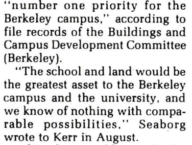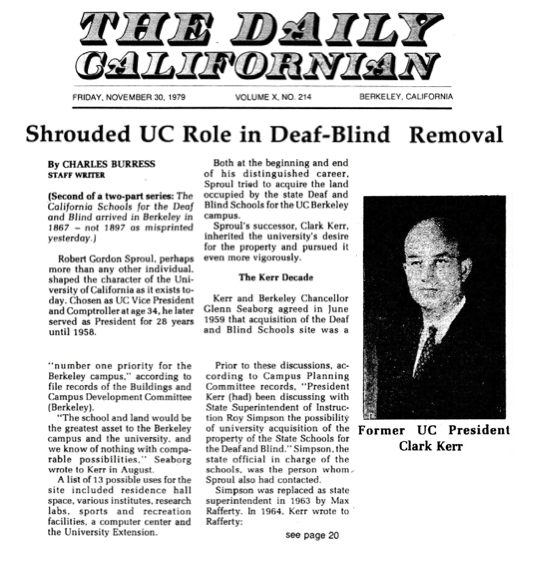Part two of a two-part series by the Daily Cal‘s Charles Burress, on the unjust scheme behind UC Berkeley’s administration planning toward the land grab on the schools for the deaf and blind. As the committee continues on as Sproul’s successor, Clark Kerr, continues on the fascination to control the future development of the Deaf and Blind property.

Prior to obtaining the site, Clark Kerr and former Chancellor Glenn Seaborg compile ideas for the development of the property. Possibilities for site development range from residence halls, research labs, recreation facilities, a medical school, and the University Extension program.
In a 1964 letter addressed between State Superintendent of Instruction Max Rafferty and Clark Kerr, the two discuss long range plans of site acquisition. Siting the “Deaf and Blind state residents are extremely proud of their respective school.” With notion, Rafferty expressed social concerns over the site take over, but references a possibility of future of thorough reviews on the deaf education in California. One such opinion came later in 1970 from the State Department of Education, expressing opinions that a possible move away from Berkeley can save Berkeley deaf students from substance use or a site expansion to introduce educational spaces for multiple disabilities.
In early 1972, a decision by the state fire marshal and the state architect finds that buildings located on the deaf and blind campus are not up to code with state fire and earthquake standards. A study conducted by the state architect determines the cost to modernize a structurally safe and up to code campus will cost the state of California significantly less than the cost to relocate the two schools.
Within the same year, the state determine the schools must relocate no matter the cost. Decisions on the move based on a new state statute prohibit any school to be situated on an active earthquake fault. Historical maps indicate an earthquake fault underneath the site, yet no geological survey is conducted to determine if the fault is present and currently active. The state prepare for a the schools to relocate at a newly fabricated school in the city of Fremont for $50 million.

When critics scold the California Department of Education on refraining from surveying the land, Assistant State Superintendent, Barry Griffing states surveying the fault lines will cost $70,000, although he previously stated to the New York Times that the survey would have cost the state $250,000. Yet the soil engineer, Ben Lennert, who soon after conducts the test for the University informs the Daily Californian newspaper staff, that the actual cost to conduct the land survey is only $15,000.
